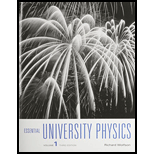
Essential University Physics (3rd Edition)
3rd Edition
ISBN: 9780134202709
Author: Richard Wolfson
Publisher: PEARSON
expand_more
expand_more
format_list_bulleted
Concept explainers
Question
Chapter 39, Problem 2FTD
To determine
The methods used to track the path of individual particles.
Expert Solution & Answer
Want to see the full answer?
Check out a sample textbook solution
Students have asked these similar questions
pls help on these
pls help on these
20. Two small conducting spheres are placed on top of insulating pads. The 3.7 × 10-10 C sphere is fixed whie
the 3.0 × 107 C sphere, initially at rest, is free to move. The mass of each sphere is 0.09 kg. If the spheres
are initially 0.10 m apart, how fast will the sphere be moving when they are 1.5 m apart?
Chapter 39 Solutions
Essential University Physics (3rd Edition)
Ch. 39 - Prob. 1FTDCh. 39 - Prob. 2FTDCh. 39 - Prob. 3FTDCh. 39 - Prob. 4FTDCh. 39 - Prob. 5FTDCh. 39 - Prob. 6FTDCh. 39 - Prob. 7FTDCh. 39 - Prob. 8FTDCh. 39 - Name the fundamental force involved in (a) binding...Ch. 39 - Prob. 10FTD
Ch. 39 - Prob. 11FTDCh. 39 - Prob. 12FTDCh. 39 - Prob. 13FTDCh. 39 - Prob. 14FTDCh. 39 - Describe the origin of the cosmic microwave...Ch. 39 - Prob. 16FTDCh. 39 - Prob. 17FTDCh. 39 - The radiation that we observe as the cosmic...Ch. 39 - Prob. 19FTDCh. 39 - Prob. 20FTDCh. 39 - Prob. 21ECh. 39 - Prob. 22ECh. 39 - Prob. 23ECh. 39 - Prob. 24ECh. 39 - Prob. 25ECh. 39 - Prob. 26ECh. 39 - Prob. 27ECh. 39 - Prob. 28ECh. 39 - Prob. 29ECh. 39 - Prob. 30ECh. 39 - Prob. 31ECh. 39 - Prob. 32ECh. 39 - Prob. 33ECh. 39 - Prob. 34ECh. 39 - Prob. 35ECh. 39 - Prob. 36ECh. 39 - Prob. 37ECh. 39 - Prob. 38PCh. 39 - Prob. 39PCh. 39 - Prob. 40PCh. 39 - Prob. 41PCh. 39 - Prob. 42PCh. 39 - Prob. 43PCh. 39 - Prob. 44PCh. 39 - Prob. 45PCh. 39 - Prob. 46PCh. 39 - Prob. 47PCh. 39 - Prob. 48PCh. 39 - Prob. 49PCh. 39 - Prob. 50PCh. 39 - Prob. 51PCh. 39 - Prob. 52PCh. 39 - Prob. 53PCh. 39 - Prob. 54PCh. 39 - Prob. 55PCh. 39 - Prob. 56PCh. 39 - Prob. 57PCh. 39 - Prob. 58PCh. 39 - Prob. 59PCh. 39 - Prob. 60PCh. 39 - Prob. 61PPCh. 39 - Prob. 62PPCh. 39 - Prob. 63PPCh. 39 - Prob. 64PP
Knowledge Booster
Learn more about
Need a deep-dive on the concept behind this application? Look no further. Learn more about this topic, physics and related others by exploring similar questions and additional content below.Similar questions
- pls help on all asked questions kindlyarrow_forward19. Mount Everest, Earth's highest mountain above sea level, has a peak of 8849 m above sea level. Assume that sea level defines the height of Earth's surface. (re = 6.38 × 106 m, ME = 5.98 × 1024 kg, G = 6.67 × 10 -11 Nm²/kg²) a. Calculate the strength of Earth's gravitational field at a point at the peak of Mount Everest. b. What is the ratio of the strength of Earth's gravitational field at a point 644416m below the surface of the Earth to a point at the top of Mount Everest? C. A tourist watching the sunrise on top of Mount Everest observes a satellite orbiting Earth at an altitude 3580 km above his position. Determine the speed of the satellite.arrow_forwardpls help on allarrow_forward
- pls help on allarrow_forward6. As the distance between two charges decreases, the magnitude of the electric potential energy of the two-charge system: a) Always increases b) Always decreases c) Increases if the charges have the same sign, decreases if they have the opposite signs d) Increases if the charges have the opposite sign, decreases if they have the same sign 7. To analyze the motion of an elastic collision between two charged particles we use conservation of & a) Energy, Velocity b) Momentum, Force c) Mass, Momentum d) Energy, Momentum e) Kinetic Energy, Potential Energyarrow_forwardpls help on all asked questions kindlyarrow_forward
- pls help on all asked questions kindlyarrow_forward17. Two charges, one of charge +2.5 × 10-5 C and the other of charge +3.7 × 10-6 C, are 25.0 cm apart. The +2.5 × 10−5 C charge is to the left of the +3.7 × 10−6 C charge. a. Draw a diagram showing the point charges and label a point Y that is 20.0 cm to the left of the +3.7 × 10-6 C charge, on the line connecting the charges. (Field lines do not need to be drawn.) b. Calculate the net electric field at point Y.arrow_forward3arrow_forward
arrow_back_ios
SEE MORE QUESTIONS
arrow_forward_ios
Recommended textbooks for you
 College PhysicsPhysicsISBN:9781938168000Author:Paul Peter Urone, Roger HinrichsPublisher:OpenStax College
College PhysicsPhysicsISBN:9781938168000Author:Paul Peter Urone, Roger HinrichsPublisher:OpenStax College Modern PhysicsPhysicsISBN:9781111794378Author:Raymond A. Serway, Clement J. Moses, Curt A. MoyerPublisher:Cengage Learning
Modern PhysicsPhysicsISBN:9781111794378Author:Raymond A. Serway, Clement J. Moses, Curt A. MoyerPublisher:Cengage Learning Glencoe Physics: Principles and Problems, Student...PhysicsISBN:9780078807213Author:Paul W. ZitzewitzPublisher:Glencoe/McGraw-Hill
Glencoe Physics: Principles and Problems, Student...PhysicsISBN:9780078807213Author:Paul W. ZitzewitzPublisher:Glencoe/McGraw-Hill Physics for Scientists and Engineers with Modern ...PhysicsISBN:9781337553292Author:Raymond A. Serway, John W. JewettPublisher:Cengage Learning
Physics for Scientists and Engineers with Modern ...PhysicsISBN:9781337553292Author:Raymond A. Serway, John W. JewettPublisher:Cengage Learning AstronomyPhysicsISBN:9781938168284Author:Andrew Fraknoi; David Morrison; Sidney C. WolffPublisher:OpenStax
AstronomyPhysicsISBN:9781938168284Author:Andrew Fraknoi; David Morrison; Sidney C. WolffPublisher:OpenStax Principles of Physics: A Calculus-Based TextPhysicsISBN:9781133104261Author:Raymond A. Serway, John W. JewettPublisher:Cengage Learning
Principles of Physics: A Calculus-Based TextPhysicsISBN:9781133104261Author:Raymond A. Serway, John W. JewettPublisher:Cengage Learning

College Physics
Physics
ISBN:9781938168000
Author:Paul Peter Urone, Roger Hinrichs
Publisher:OpenStax College

Modern Physics
Physics
ISBN:9781111794378
Author:Raymond A. Serway, Clement J. Moses, Curt A. Moyer
Publisher:Cengage Learning

Glencoe Physics: Principles and Problems, Student...
Physics
ISBN:9780078807213
Author:Paul W. Zitzewitz
Publisher:Glencoe/McGraw-Hill

Physics for Scientists and Engineers with Modern ...
Physics
ISBN:9781337553292
Author:Raymond A. Serway, John W. Jewett
Publisher:Cengage Learning

Astronomy
Physics
ISBN:9781938168284
Author:Andrew Fraknoi; David Morrison; Sidney C. Wolff
Publisher:OpenStax

Principles of Physics: A Calculus-Based Text
Physics
ISBN:9781133104261
Author:Raymond A. Serway, John W. Jewett
Publisher:Cengage Learning